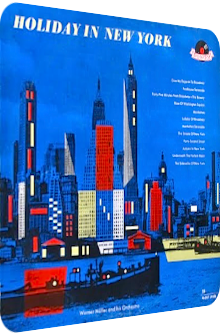
Werner Müller
Holiday In New York
1956
Holiday In New York belongs to the early entries of the quite famous Holiday In… series as envisioned, orchestrated and arranged by German conductor and big band leader Werner Müller (1920–1988). You can’t make a career with such a name, and that’s why the album is also cross-released under Müller’s fiery moniker Ricardo Santos. Both names aren’t archetypal names for New York, but they capture and encapsulate the international atmosphere and savoir vivre of this beautiful place.
Released in 1956 on Decca, Polydor and other local labels, its 13 songs and 12 tracks (one of them a short medley) are inspired by the tall skyscrapers, blue skies and architectural landmarks of New York, no surprise, and ultimately viewed from a tourist’s rose-tinted perception. It’s a holiday release after all, so there’s no saddening or threatening tone sequence in sight. Strings and horns make up the basic soundwaves of each arrangement, with additional xylophones, flutes and harmonicas appearing here and there, more so during the album’s second half. Although Müller is known for his songwriting skills, with 1963’s East Of India being the epitome of his creativity, Holiday In New York relies on genre gems, gold standards and evergreens, all of which are inspected below.
The streets of New York are running like clockwork… in 3/4 time. One of them, Forty Second Street by Al Dubin and Harry Warren gets the full treatment in typical Werner Müller style. Merging whirling strings with a xylophone-accompanied pizzicato punctilio and complementing them with sun-dappled brass suprematism, the opener depicts the insouciance of a holiday without the hassle of the bustling megacity’s noise level. Val Burton’s and Will Jason’s Penthouse Serenade (When We’re Alone) is even more transfigured; basking in auroral pectiniform strings and allowing room for a lachrymose lead fiddle, the arrangement is eminently silky and only allows the mountainous horns to come through near the end. A surprisingly great interpretation, but admittedly for all the wrong reasons, as the metro jungle below the penthouses cannot even come through in the slightest.
Victor Herbert’s The Streets Of New York surely must mean business though, right? Only in the most glorified and enchanted way, as Müller and his orchestra succumb to another cautiously foggy syncytium. Here, however, the brass and woodwind side is more diversified, with the muted trumpets delivering the adaxial standout texture. Afterwards, Ballard MacDonald’s and James F. Hanley’s Rose Of Washington Square is the first lively Saturday night showtune the maestro comes up with, surprising with its tetragonal brass blasts, Honky Tonk piano lycopods and woodpecker xylophones texture-wise, before Manhattan by Richard Rodgers and Lorenz Hart returns to a string-infested bird’s eye perspective over the high rise buildings and matutinal air in aural technicolor. Louis Alter’s Manhattan Serenade then serves as the lively interim endpoint, with its first half comprising of fibroblasts and trumpet solos and its latter half augmenting these elements in true-fashioned showman style. It’s getting more elaborate here, in an Easy Listening kinda way, mind you.
Give My Regards To Broadway by George M. Cohan kicks off side B, and it feels like the coach ride it should be, marrying galloping rhythms, joyously fluttering strings and tapdance sections in order to create a wonderworld’s megafauna of artificiality. For better or worse, Charles B. Lawlor’s and James W. Blake’s Sidewalks Of New York inherits many of these traits, albeit in a 3/4 corset. Even though no barrel organ is involved, the tone sequences make would make it a suitable choice for this instrument. In addition, the frilly flutes share a surface-related sentiment amid the strings anyway.
Autumn In New York by Vernon Duke widens the instrumental pool yet again by placing a bittersweet French harmonica in much more gregarious string fusillades, just before the two-part medley launches: Forty Five Minutes From Broadway by George M. Cohan rather resembles 45 seconds only, with its vitreous triangle/xylophone transparency residing in the magical realm, with elements of Charles H. Hoyt’s and Percy Gaunt’s The Bowery sewn in, and all of this in less than three minutes, making it a lackluster medley. With Harry Revel’s and Mack Gordon’s Underneath The Harlem Moon creating an excitingly nocturnal pastime alright with a lead trumpet and a full showtune orchestra in the epicenter, Lullaby Of Broadway lets the album come full circle, as it is the second composition written by Al Dubin and Harry Warren, and an eclectic one it is too, merging spy-themed Jazz placentas with the many grandiloquent showtune centrioles and romantic string-mandated encapsulations.
Werner Müller’s Holiday In New York is the expected trumpet-and-string journey through a beautiful city, and while it doesn’t feature the least Exotica-related bit, there are two enthralling things to consider regardless. At first, it offers a fantasy-driven, surreal look where the concrete jungle melts into colorful walls and lacunar alleys. Similar to Felix Slatkin’s Street Scene (1961), Müller’s trip to New York is focused on streets and, for better or worse, pretty much grounded, or bound to earth most of the time. However, it is the second step that makes the album comparatively valuable, and that is the waves of warmhearted nostalgia and mellow memorabilia it invokes. The value is hard to pinpoint after an easy head start: the album is no collector’s item, for it is easily available in various formats, with lots of different front artworks gracing the vinyl and even download versions.
It isn’t a good Easy Listening album per se either, as the material is based on standardized instrument and aural visuals, so to speak. And to put the final nail in the coffin, it isn’t an Exotica album, what a shock! The insouciance is somewhat comprehensive and nutritious though, the look back isn’t pestered with sighs of gravitas or a petrifying yearning. The strings are admittedly whitewashed and purified, but the brassier constituents give the album a certain edge a lot of times. This may not be the New York of your dreams, but it’s a mediocre entry in Werner Müller’s Holiday series, certainly much more efficient and charming for Europeans and tourists than the locals.
Exotica Review 446: Werner Muller – Holiday In New York (1956). Originally published on Aug. 15, 2015 at AmbientExotica.com.
